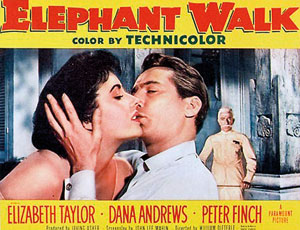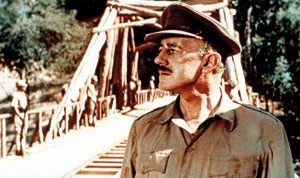The first use of Ceylon as the location for a fiction film rather than a documentary was in 1936, when the 27-minute Jaws of the Jungle, (aka Jungle Virgin in the US), about an attack by “swarms of vicious vampire bats” on a Ceylon village, was directed by the horror-inspired Hollywood scriptwriter (The Amazing Exploits of the Clutching Hand, etc.), Eddie Granemann.
The Second World War and its austere aftermath curtailed further use of the island’s splendid locations, so it wasn’t until the early 1950s that recognized British and American directors arrived in force to make a handful of mostly acclaimed feature films either partly or wholly shot on the island. The only unfortunate aspect was that just one of the stories was actually set in Ceylon. Nevertheless, in my opinion the 1950s was the golden decade of foreign filmmaking in the country.
 |
| Bewildered bride: Elizabeth Taylor in The Elephant Walk |
 |
It began in 1951–1952, during which Briton Carol Reed directed the UK-produced Outcast of the Islands, made in black-and-white, starring Trevor Howard, Ralph Richardson, Peter Morley and Wendy Hiller. The film is based on Joseph Conrad’s pessimistic second novel, An Outcast of the Islands (1896) – note that “An” was dropped from the film title - inspired by the author’s seafaring experience.
Trevor Howard plays a degenerate British expat, Peter Willems, on the run in Indonesia from a scandal in Makassar, who finds refuge in a village of cannibals but spoils things by chasing after the chief’s daughter. None of the characters is particularly likeable; even Willems loses audience empathy by betraying a close friend, Captain Lingard (a recurring character in Conrad’s stories), played by Ralph Richardson. Yet as an online reviewer remarks, “to ignore Trevor Howard’s marvellous portrayal of Conrad’s pathetically inadequate Willems would be to pass over one of British cinema’s finest performances”.
When Outcast of the Islands was released it received indifferent reviews, probably because it followed Reed’s three greatest films, Odd Man Out (1947), The Fallen Idol (1948) and The Third Man (1949). Nevertheless, it was nominated for two BAFTA (British Academy of Film and Television Arts) awards, and today is generally considered the best film of one of Conrad’s tales. Some may suggest Francis Ford Coppola’s Apocalypse Now (1979), based on Heart of Darkness (1902), but the location and period were changed, whereas Outcast of the Islands is a more faithful rendition of Conrad’s work.
In 1953, the highly-regarded Reed became only the second filmmaker to be knighted for his services to the industry (the first being Alexander Korda).
Reed went on to make Our Man in Havana (1959) and Oliver! (1968), for which he won an Academy Award for Best Director. In 1952, compatriot Ken Annakin (whose later films included the wacky Those Magnificent Men in their Flying Machines and the bloody Battle of the Bulge) directed The Planter’s Wife (aka Outpost in Malaya in the US). This UK-produced film, made in black-and-white, is based on the novel of the same name by the popular war author, Sidney Charles George, and stars Claudette Colbert, Jack Hawkins and Anthony Steel. A supporting actor, primarily known as a classical Indian dancer, was Ram Gopal. He worked on several films in Ceylon and I was fortunate to befriend him in London in the 1970s but cannot reveal his reminiscences.
The Planter’s Wife concerns a rubber planter and his wife who struggle to defend their home against communist insurgents during the Malayan Emergency. One online reviewer comments: “While Anthony Steel and Hawkins are both excellent, Colbert is the weak link. Prone to hysterical outbursts, for someone in her supposed position, she lacks the toughness one would expect.”
During 1953, Paramount Pictures’ Elephant Walk was directed by William Dieterle, a German who emigrated to the US in 1930 and soon gained a Hollywood reputation. Based on Robert Standish’s novel of the same name published in 1948, Elephant Walk is the one film from this period set in Ceylon. It’s a tale of a bride newly arrived from England who has to contend with her tea-planter husband’s father complex, the fact that she is the only white woman in the district, and the rampages of a herd of elephants.
Initially, Vivien Leigh played the bride, but she was suffering from psychological problems that began to affect the filming (it didn’t prevent her visiting Bevis Bawa at Brief), so Elizabeth Taylor replaced her, although Katherine Hepburn, Olivia de Havilland and Jean Simmons were considered for the role. Dieterle, who apparently always wore a large hat and white gloves on location, weathered this crisis, and Leigh can be seen in certain long shots. Peter Finch played Taylor’s husband, while Dana Andrews provided some extra-marital romantic interest.
Ram Gopal was the choreographer of an extravagant Kandyan dance sequence featuring performers of the Madhyma Lanka Nritya Mandala, established several years earlier by Suramba Gurunnanse, which is today housed in a building designed by George Keyt at Gunnepana, near Kandy.
One online reviewer enthuses: “William Dieterle does a masterful job of bringing a somewhat dark, and almost eerie, undertone to this romance and the setting is one of the most beautiful I’ve seen with the black-and-white themed mansion and the gorgeous island scenery.”
The same year saw the part-production in Ceylon of a West German film Sterne über Colombo (“Stars over Colombo”), directed by Veit Harlan and starring Kristina Söderbaum, Willy Bergel and Adrian Hoven, with an appearance by Sujata Jayawardena. I haven’t seen the film so cannot comment on it, but research reveals that in 1954 Jayawardena acted in Harlan’s next film, Die Gefangene des Maharadscha (“Circus Girl”), which was also partly shot in Ceylon, and in 1962 acted in a surprisingly fast remake, Die Blonde Frau des Maharadscha (“The Maharaja’s Blonde”), again partly filmed here. All three films, shown internationally, featured the same lead players.
Mainly shot in Ceylon in 1954, the UK-produced The Beachcomber, directed by Muriel Box and starring Donald Sinden, Glynis Johns, Donald Pleasance and Michael Horden, was the second screen adaptation of Somerset Maugham’s story “The Vessel of Wrath”. The story concerns the small British community in the Welcome Islands (although situated in the south Atlantic they were transposed to the Indian Ocean), the governor, Martha and Owen, brother and sister missionaries, and the self-styled ‘the Honourable Ted’, a hard-drinking, womanizing social outcast. When cholera threatens the island’s indigenous inhabitants, the unlikely pair of Martha and Ted work together to stop its spread.
The director and screenwriter Muriel Box is notable as she overcame many gender obstacles in the male-dominated industry to become one of the most successful females in the annals of British film. Having won an Academy Award for Best Original Screenplay for The Seventh Veil (1945), Box began to direct films with often controversial themes such as teenage sex, abortion, illegitimacy, and her choice subject, the female experience, explored in The Beachcomber. Ironically, prejudice against Box was sometimes shown by females: in 1950 Jean Simmons had her replaced as director on So Long at the Fair.
Another film shot almost entirely on location in Ceylon in 1954 was the UK-produced The Purple Plain, directed by former actor and editor Robert Parrish (he won a shared Oscar in 1947 for his editing of Robert Rosen’s Body and Soul), which stars Gregory Peck, Win Min Than (her only screen appearance), Bernard Lee and Maurice Denham - supported by Ram Gopal as “Mr Phang”!
The Purple Plain is based on the novel of the same name published in 1947 by the prolific and successful author H.E. Bates: the script was written by the master spy novelist, Eric Ambler, in consultation with Bates.
The film is a credible World War Two drama set in Burma in which, unusually, the Japanese make no appearance. Gregory Peck plays a Canadian pilot, Bill Forrester, serving in the RAF, who flies a Mosquito, mostly made of wood, one of the war’s most remarkable planes. Forrester, stationed at a jungle-bound airfield (filmed at Sigiriya), is haunted by the memory of the loss of his wife on their wedding night during an air raid and doesn’t care whether he dies in combat – that is until he meets a delightful Burmese girl. Then he is shot down, together with his navigator and a passenger secreted in the bomb bay, over a remote desert area (Elephant Pass) and has to survive the hostile environment and reach a river (the Kelani Ganga, Kitulgala). Forrester realizes he has something to live for, while the passenger commits suicide. One online reviewer comments: “It’s not much of a plot, but it’s handled extremely well thanks to Parrish’s direction, which is surprisingly strong, direct and imaginative when called for, but still knows when to be unobtrusive as well.”
The Mosquitoes used in the film, provided by the RAF, were repainted in the correct camouflage and carried authentic markings. The RAF also provided much assistance on location. It was good timing for the production as the Mosquito was withdrawn from service the next year, 1955.
The film was a box-office success and was nominated in the category Best British Film of 1954 at the 8th British Academy Film Awards, while Maurice Denham was nominated for the BAFTA Award for Best Actor in a Leading Role. Parrish subsequently directed, among other films, the Journey to the Far Side of the Sun (1969), considered one of the finest pre-Star Wars sci-fi movies.
In 1956-1957, the best-known film of the period in question, the UK and US co-production The Bridge on the River Kwai, was produced in Ceylon by Sam Spiegel and directed by David Lean, who had already gained recognition with Brief Encounter (1945), Great Expectations (1946), and Oliver Twist (1948). The film, which stars William Holden, Alec Guinness, Jack Hawkins (his second film in Ceylon after The Planter’s Wife) and Sessue Hayakawa, is based on Pierre Boulle’s novel Le Pont de la Rivière Kwaï (1952), set in Burma although the author was a prisoner of war in Thailand. The scriptwriters were Carl Foreman and Michael Wilson, blacklisted at the time, so they received no credits. Boulle, who knew no English, was credited instead.
 |
| An Oscar for his role: Alec Guinness starring in The Bridge On the River Kwai |
The story, which borrows the construction of the Burma-Siam railway in 1942–43 for its historical setting, centres on Colonel Nicholson, played by Alec Guinness, the officer in command of a group of newly-arrived British servicemen at a Japanese prisoner-of-war camp. Nicholson is incarcerated in ‘the oven’, an iron box, by the camp’s commander, Colonel Saito, for refusing to allow his officers to work on the building of the bridge, but in the end Saito relents as the work is being sabotaged by the British prisoners.
Under the subsequent leadership of Nicholson, however, they are persuaded – although some officers protest - that the bridge should be constructed as a symbol of British morale, spirit and dignity. Although Nicholson believes the bridge is a monument to British character, his insistence on its construction becomes a subtle form of collaboration with the enemy. British audiences picked up on this hint of collaboration, which I witnessed four years after the film’s release while on holiday in the Scilly Isles, off Cornwall. Alec Guinness, who was knighted in 1959, was staying at the same hotel, and I overheard much conversation among the guests on the subject.
Assistant director John Kerrison was killed in a car crash on the way to one of the locations. His replacement was the Italian Gus Agosti, a stereotypical tough, bellowing, sergeant major-like first assistant director, who had ‘commanded’ the production of big films such as Ben Hur (1959) and Thunderball (1965). Those of us who worked on Lester James Peries’ The God King (1973) got to know his dictatorial methodology well, for he was hired to save the production after the film’s initial collapse. And that’s just what he did.
Locations included Ambepussa, Colombo, Kandy, Mahara, Mount Lavinia Hotel, Peradeniya Botanical Gardens, and, most importantly, Kitulgala and the nearby Kelani Ganga, across which the bridge - at the time the biggest construction specially made for a film – was built between June and December 1956.
A dressed-up jeep towing mock-up carriages was decided upon for the scene in which the bridge is destroyed. But then the Ceylon Government Railway offered a disused 55-year-old steam engine. Track a mile in length had to be constructed for a locomotive to accelerate and cross the bridge at reasonable speed. In addition, provision on the opposite bank for stopping a driverless train in case the explosion did not occur was necessary.
An explosives expert from ICI supervised the placing and firing of the charges. The engine driver was to jump off before reaching the bridge into a shelter, where he would throw a switch that would be the signal for the firing of the explosives.
A grandstand had been built downstream for Prime Minister SWRD Bandaranaike and other VIPs who were present on March 11, 1957, the red-letter day. There were five cameras positions, one of which was a control point where Lean was stationed. However, things did not go according to plan. Although the driver performed his duties, one camera position didn’t respond, so Lean decided to abort the take. The train and its wagons full of rubber dummies of Japanese soldiers crossed the bridge, de-railed on the opposite side, and overturned spectacularly.
Working throughout the night, the train was put back on the track. The next morning everything went according to plan, and after the explosion the train fell perfectly into the middle of the river just as Lean had envisaged.
Bridge won no less than seven Oscars in 1958 – Guinness for Best Actor in a Leading Role, Jack Hildyard for Best Cinematography, Lean for Best Director, Peter Taylor for Best Film Editing, Malcolm Arnold for Best Music (Scoring), Spiegel for Best Picture, and, crazily, Boulle for Best Screenplay based on Material from Another Medium (Foreman and Wilson were posthumously awarded this Oscar in 1984). Sessue Hayakawa was nominated for Best Supporting Actor. The film won a host of other awards, including a BAFTA for Best British Film of 1958, a Grammy for Malcolm Arnold, Golden Globes for Guinness and Lean - even Gus Agosti received an award for Outstanding Directorial Achievement in Motion Pictures from the Directors Guild of America. No other film made in the country has received such accolades.
Some may say the 1980s, 1990s and the first decade of this century are more important in the history of foreign filmmaking in Sri Lanka because of the participation of local production personnel and actors, together with the provision of location facilities and funding. Several excellent films were made during this period, but there’s also been much dross. Consider the consistent quality of the films of the 1950s, due to several factors.
Scripts were mostly based on the novels of some remarkable writers, especially Conrad and Maugham, and some reputed directors were involved, especially Lean, Parrish and Reed, not forgetting a number of renowned cinematographers and others. And some of the finest British actors of the period appeared - Maurice Denham, Peter Finch, Alec Guinness, Jack Hawkins, Wendy Hiller, Michael Horden, Trevor Howard, Glynis Johns, Peter Morley, Donald Pleasance, Ralph Richardson, Donald Sinden, and Elizabeth Taylor.
(This article is dedicated to Lester James Peries who encouraged my interest in the subject on the summit of
Sigiriya in 1973. ) |




